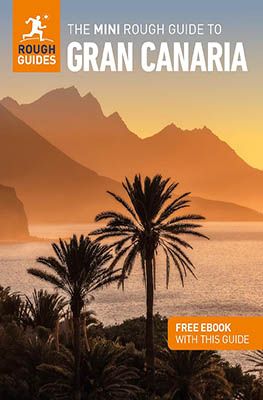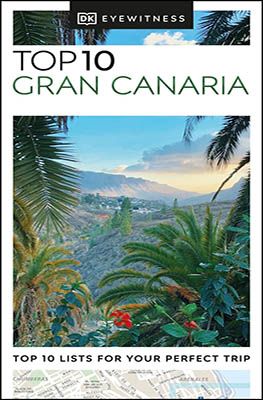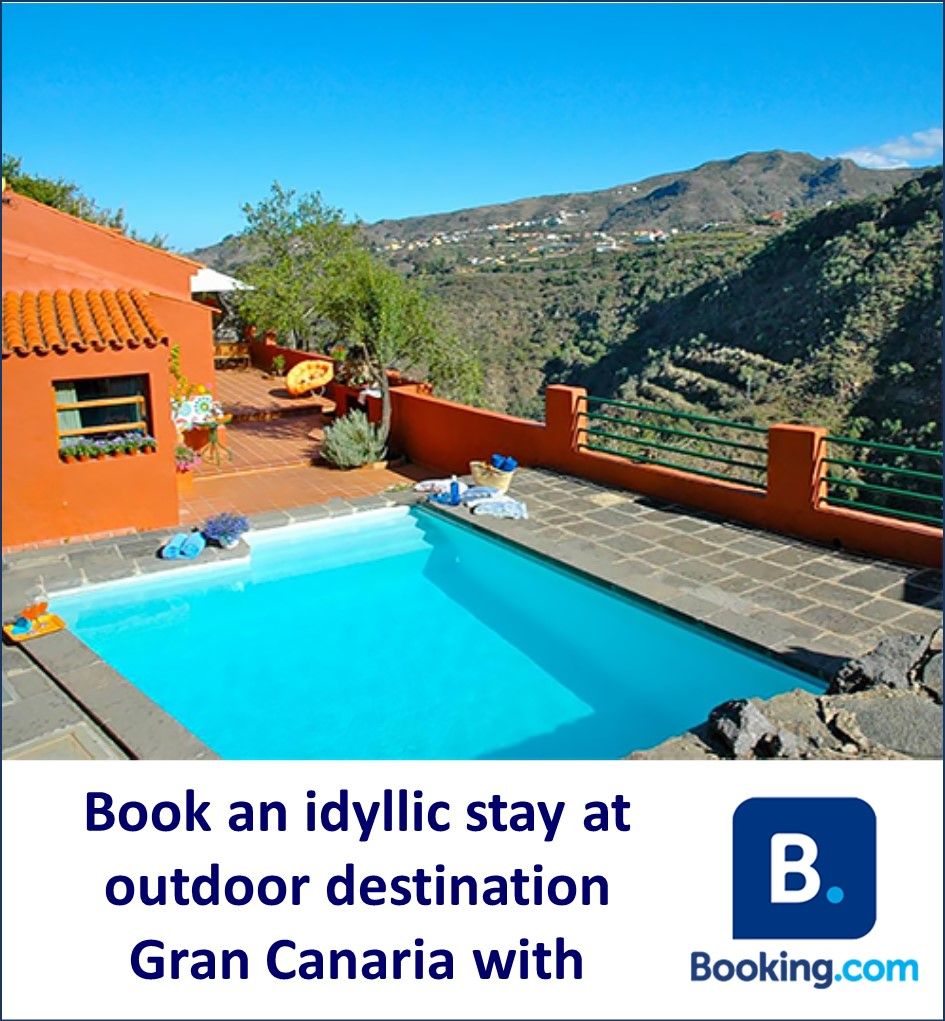At the beginning of spring, we journeyed to the sunny island of Gran Canaria. Our main goal? Plenty of hiking and soaking up the much-needed vitamin D thanks to the sunny climate. Now, with numerous stunning walks under our belt, we can safely say that our mission has been accomplished. Gran Canaria has also met our high expectations. It’s the variety between picturesque towns and villages, beautiful beaches, and breathtaking landscapes that particularly appealed to us. In this blog, we’ll introduce you to the versatile Gran Canaria, a sunny destination for an active holiday.
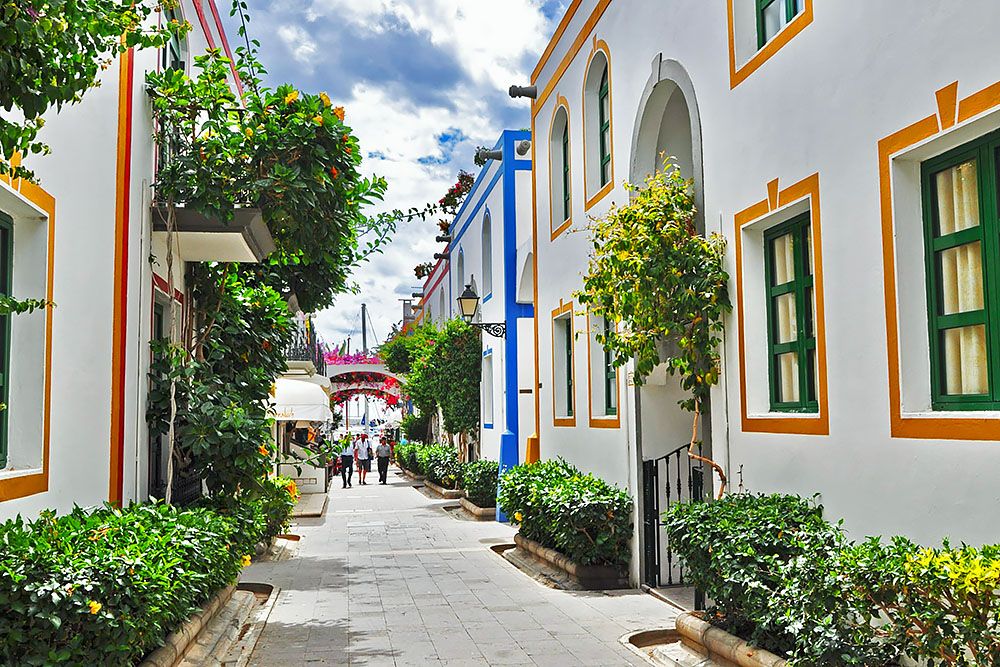
History of Gran Canaria
There are various theories about the early population of Gran Canaria. Research suggests a link with North Africa and the Berbers. The island was likely colonized around 500 BC. Most people and cultures that settled in the pre-Spanish period in the archipelago settled on Gran Canaria.
The conquest of the island took place during the reign of the Catholic Monarchs at the end of the 15th century. From that moment, the Crown of Castile began to exert political, social, and economic influence on Gran Canaria. The capital of Gran Canaria became the administrative center of the archipelago. In the 17th century, the splendor of Gran Canaria began to diminish due to a decrease in the export of agricultural products to America and Europe.
However, the emergence of the free port system in the nineteenth century brought a wave of international shipping. This led Gran Canaria to develop into a thriving tourist destination. Despite the two world wars and the Spanish Civil War, the island has managed to maintain its position as a beloved tourist destination.
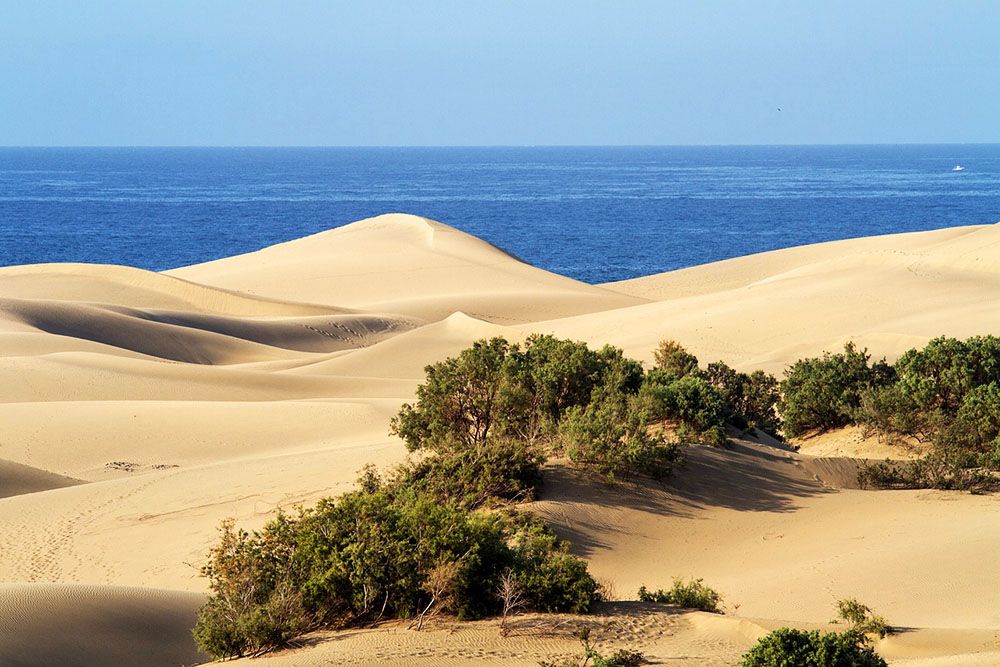
The many outdoor activities on Gran Canaria
We primarily visited Gran Canaria for hiking. However, due to the diverse landscapes and climate, Gran Canaria also offers other outdoor activities such as cycling, horse riding, water sports, and playing golf. In this blog, we will go into more detail about the hiking and cycling possibilities.
Hiking on versatile Gran Canaria
We’ve previously enjoyed fantastic walks on the neighboring island of La Palma, known as the hiking island of the Canary Islands. Perhaps that’s why our expectations of the hiking opportunities on Gran Canaria weren’t particularly high. Ultimately, the island pleasantly surprised us. The volcanic island offers diverse and breathtaking nature, ranging from deeply carved barrancos to lush green oases, and from barren deserts to grassy plateaus.
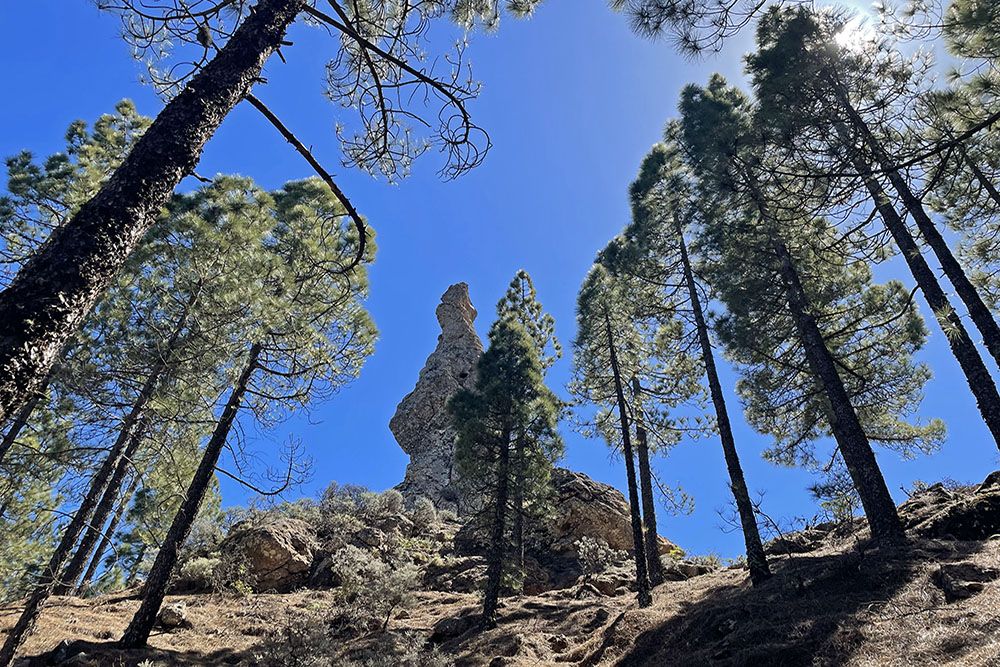
Diverse landscape
Gran Canaria is a world of contrasts. In the south, you’ll find bone-dry desert areas and mountain landscapes, while in the north, there are evergreen laurel forests. The imposing central mountain range, the Cumbre, forms a climatic divide. The rugged, nearly two-kilometer-high mountain range of Gran Canaria acts as an insurmountable barrier to clouds from the northern Atlantic Ocean. The relatively high moisture content is a boon for the many plant species abundant in the north, including five hundred endemic species. By the way, we also saw this more or less reflected on La Palma.
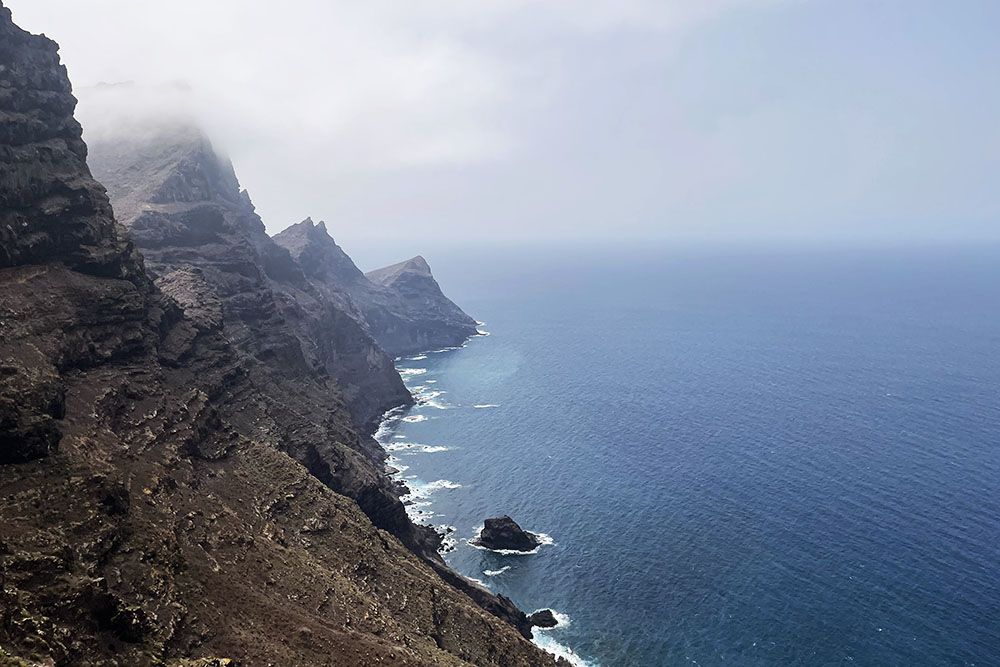
Amazing hiking opportunities
The island harbours beautiful natural areas where we, as hiking enthusiasts, can easily spend hours enjoying. Such as the Tamadaba Nature Park, home to Gran Canaria’s largest primeval forest. You can climb to the top of Alta Vista or admire the Table Mountain of Acusa. Furthermore, the nature reserve of Las Dunas de Maspalomas in the south is an exceptional area for hiking. It features desert dunes and an oasis with a palm grove.
It’s primarily this varied landscape of Gran Canaria that particularly appeals to us. Every day was a delight with beautiful views, picturesque white villages built against the mountain slopes, and iconic rock formations such as Roque Nublo and Bentayga.
You can find an abundance of hiking trails on the official tourist website of Gran Canaria. It would take you many months to do them all. We didn’t find any GPX tracks, but the route descriptions are generally good. Additionally, most hiking trails are well marked. If you still want to hike based on a GPS track (GPX), also check out the websites of Komoot and AllTrails.
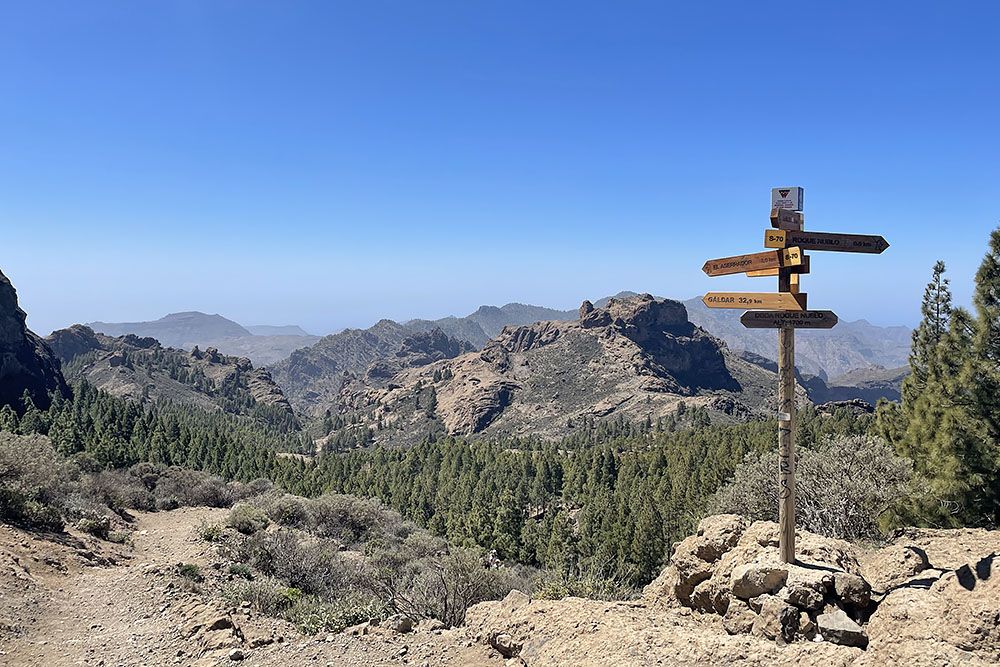
The most beautiful hiking trails on Gran Canaria
To help you make a choice from the particularly large offering of hiking trails, we’ve compiled some of the most beautiful walks for you:
- Roque Nublo and Roque Bentayga – The walk to Roque Nublo and Roque Bentayga offers an unforgettable experience. We found it to be quite busy with hikers, but the spectacular views, including Caldera de Tejeda, more than made up for it.
- Dunas de Maspalomas – A walk through the dunes of Maspalomas is truly a unique experience in a desert-like environment. There are multiple routes. We’ve placed a link here to an eight-kilometre walk. Several pleasant eateries are situated along the route. Therefore, it might be wise to do the walk towards the end of the afternoon.
- Barranco de los Cernícalos – This hiking trail leads through a lush ravine with several waterfalls. It’s a beautiful green, picturesque environment. You certainly won’t be the only hiker here.
- Circular route at Pico de las Nieves – This route offers breathtaking views of the island’s highest peaks. The almost 9.5-kilometre, challenging hike is essentially only suitable for experienced hikers.
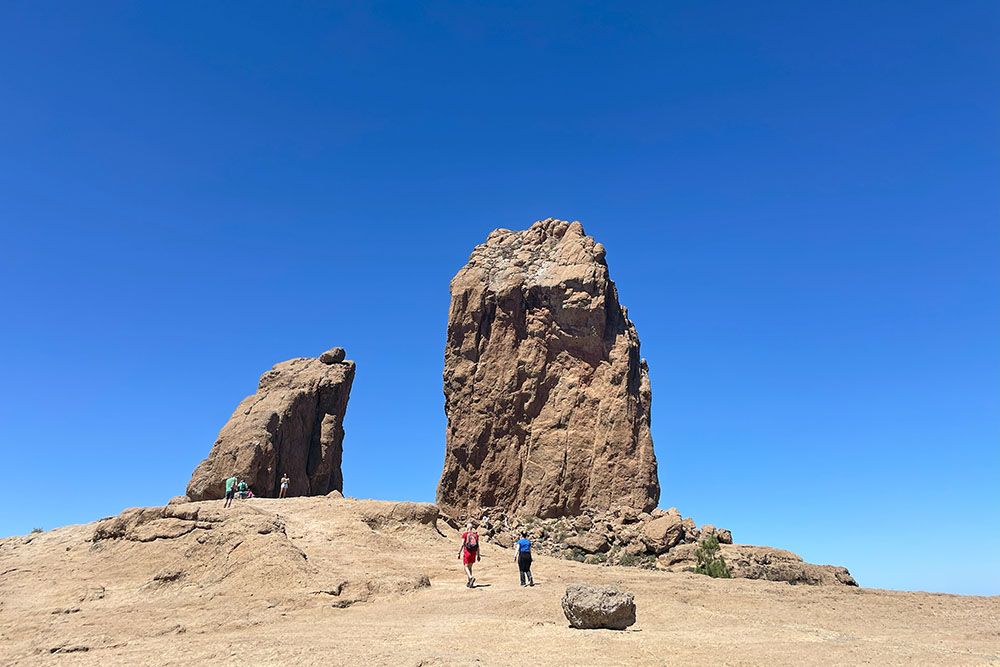
The Camino de Santiago de Gran Canaria
The ultimate trek on the island is the Camino de Santiago de Gran Canaria. This 66-kilometre-long pilgrim’s route crosses the island from south to north. It features a succession of rugged volcanic landscapes with occasional authentic villages. It is the only Camino de Santiago route outside continental Europe and the only route that does not start or end in Santiago de Compostela. The Camino starts at Faro de Maspalomas and ends at the church of Santiago de Las Caballeros in Gáldar.
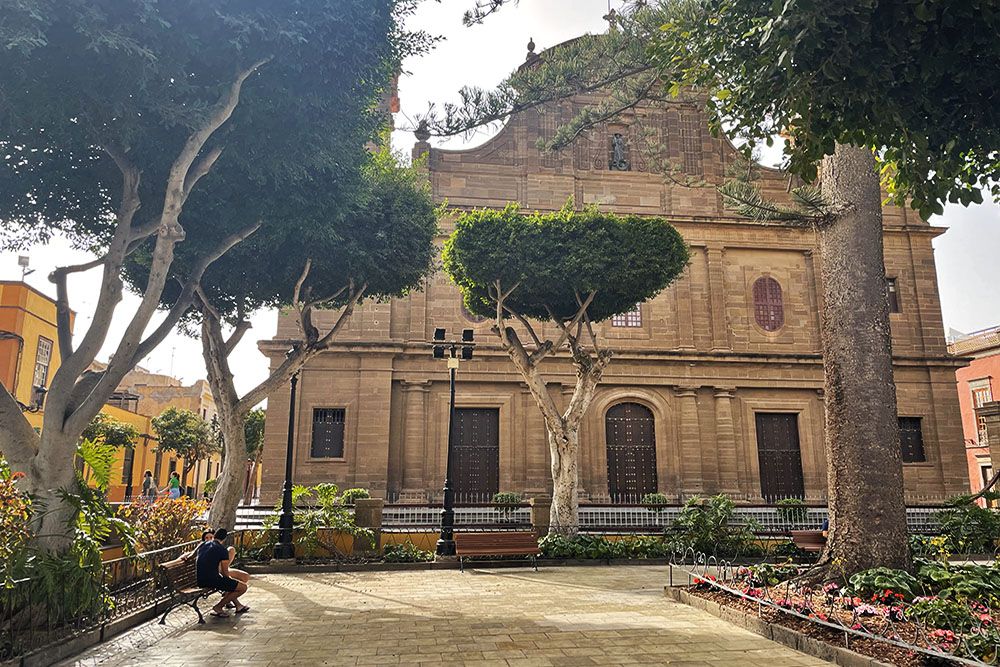
Annual hiking event on Gran Canaria
Every year in October, the Gran Canaria Walking Festival takes place. This festival offers a unique opportunity to explore the island’s spectacular nature. During the Gran Canaria Walking Festival, there are various routes to follow, each with its own unique characteristics. From breathtaking mountain paths to leisurely walks along the coast, the festival offers something for everyone. For adventurous hikers, there’s even the possibility to take part in a fascinating night tour, allowing you to walk beneath the beautiful starry sky and enjoy the tranquillity.
One of the most remarkable aspects of the Gran Canaria Walking Festival is the opportunity to meet people from all over the world. Sharing hiking experiences, admiring the natural beauty, and enjoying the collective passion for hiking creates a unique atmosphere of international solidarity.
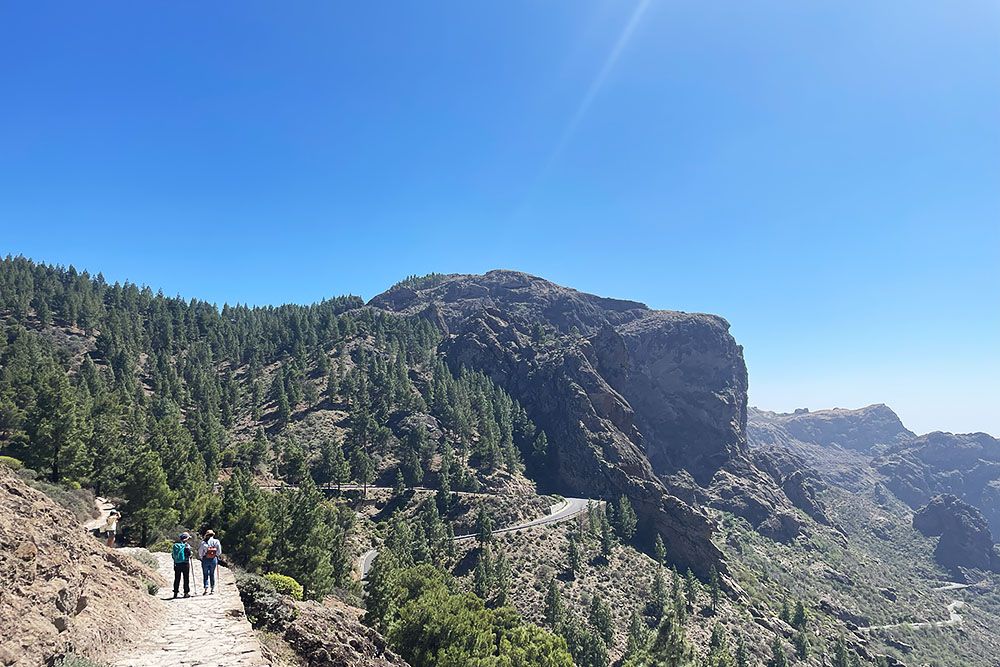
Cycling in the mountainous Gran Canaria
What we only discovered during our stay on the island is that Gran Canaria is a veritable paradise for the sporty cyclist. There are also cycling routes over relatively flat terrain, but the vast majority of all routes are more geared towards the (experienced) cyclist. During our car rides from one hike to another, we encountered a significant number of cyclists. They occasionally had to pedal hard; inclines of more than 10% are actually more the rule than the exception. Due to time constraints, we didn’t venture into cycling. However, given the excellent facilities for cyclists (including many bike rental companies with high-quality bikes and e-bikes), we will definitely consider cycling for a future visit to this fantastic island. On websites such as routeyou.com, Komoot, and AllTrails, you can find the most beautiful routes.
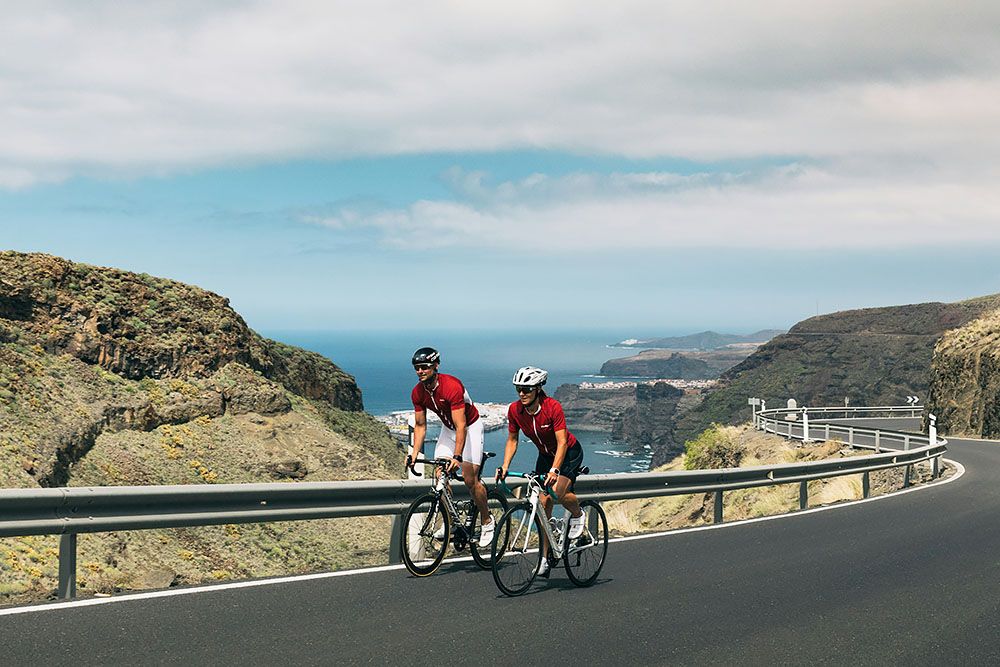
The Most Beautiful Beaches on Sunny Gran Canaria
Gran Canaria has traditionally been known for its beautiful beaches. From vast sand dunes to secluded coves, the island offers plenty of beaches worth visiting. We’ve listed some of the most beautiful beaches of Gran Canaria for you.
- Anfi del Mar, located in the south of Gran Canaria, is an idyllic beach with fine, white sand and calm, turquoise seawater. Due to the calm waters and the beautiful surroundings with colourful flowers and swaying palm trees, it’s popular with families.
- Playa de Amadores: this beach is known for its azure waters and soft, powdery white sand. It’s ideal for those seeking tranquillity, as music and sports activities are not allowed. The sheltered location provides calm swimming water, while the surrounding facilities cater to all the necessary comforts for a perfect day at the beach.
- Playa de Güigüi, situated on the remote west coast of Gran Canaria, is an unspoilt beach only accessible via a challenging hike. The crystal-clear sea, rugged surroundings, and tranquillity make this beach a unique and unforgettable destination for beach lovers seeking a secluded paradise.
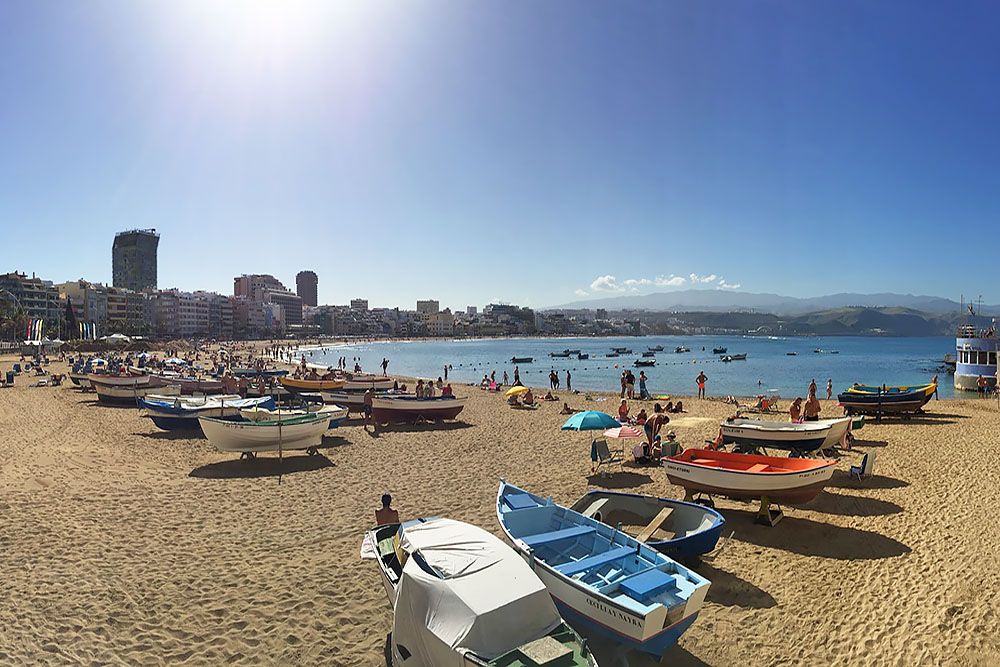
- Playa de Las Canteras, located in the bustling capital Las Palmas, is one of the best city beaches in Europe. With its 2.8-kilometre-long golden sandy beach, it provides the perfect setting for a relaxing beach stroll. Additionally, there are numerous opportunities to savour local cuisine at nearby restaurants. This beach is a favourite spot for both locals and tourists.
- Playa de Maspalomas near the iconic, majestic dunes of Maspalomas in the south of Gran Canaria. Here you’ll find a spectacular backdrop of sand dunes and an expansive beach that has something to offer for everyone. A must-visit!
In addition to these beaches, there are many other beautiful beaches on Gran Canaria, such as the cosy Sardina del Norte, the volcanic beach Tufia, and the iconic Playa del Inglés.
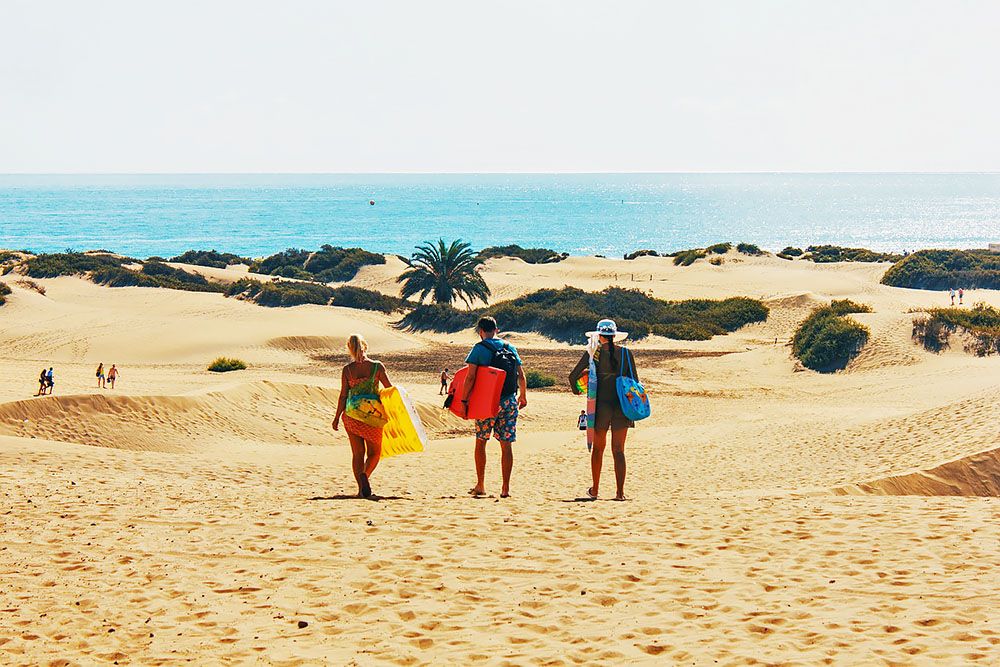
Immersing in Gran Canaria’s surprising culture
Gran Canaria boasts a rich cultural history and interesting, vibrant traditions. From colourful festivals to historical landmarks, the island offers a wealth of cultural experiences.
Traditional village festivities, festivals, and other events
One of the best ways to experience the local culture is by participating in the traditional village festivities that take place throughout the year on the island. During these celebrations, the local population and visitors come together to enjoy music, dance, culinary delights, and colourful processions. Whether it’s the festival of San Juan in June or the celebration of a village’s patron saint, these festivities offer a lively insight into local traditions and customs.
Additionally, Gran Canaria is the stage for a variety of festivals and events that take place throughout the year. From colourful carnival celebrations to religious processions and music festivals, there is always something to celebrate on the island. But there are also other annual celebrations, many of which are rooted in religious or ancient traditions, such as the festival in honour of the Virgen del Pino, or El Charco.
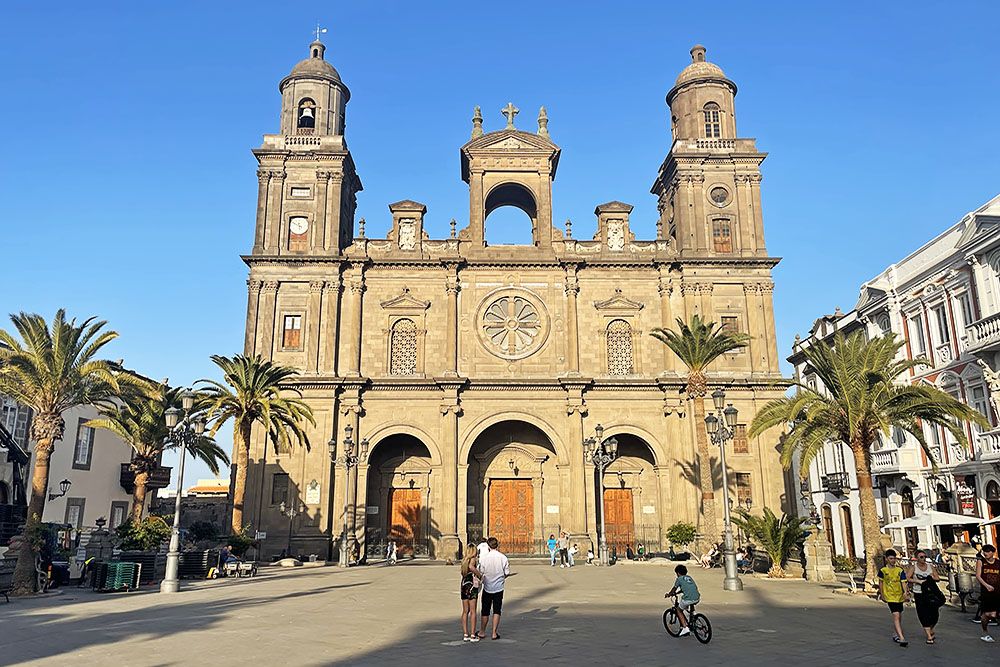
Historical landmarks
Gran Canaria harbours a treasure trove of historical landmarks that provide a glimpse into the island’s past. For example, visit the historic district of Vegueta in Las Palmas, where you can wander through cobbled streets and admire the impressive Santa Ana Cathedral. A separate blog about Las Palmas will be available soon.
Furthermore, there are many other particularly charming towns and villages that are definitely worth a visit. Such as Puerto de Mógan, the Venice of the Canary Islands. But also the mountain villages of Teror, Tejada, and Galdár are a must-see during a tour of the island!
Explore the ancient cave dwellings of the original inhabitants, the Guanches. You’ll find these in the valley of Guayadeque.
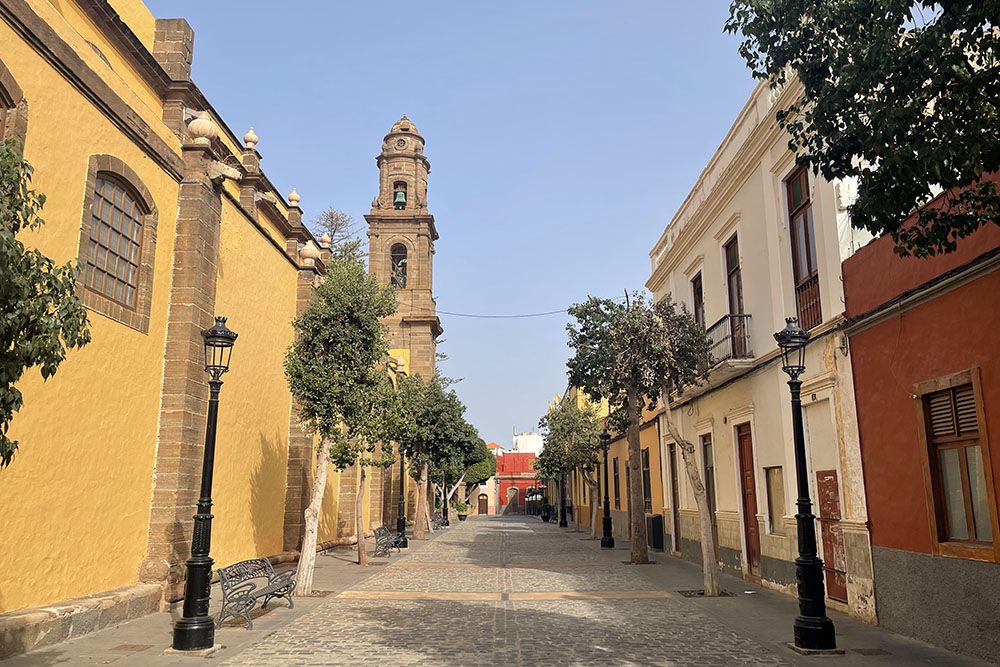
Local crafts and art
A stroll through the local markets and artisan shops offers the chance to admire traditional Canarian crafts, such as embroidery, pottery, and basket and chair weaving. Additionally, the island hosts a thriving art scene, with galleries and artist collectives providing a platform for local and international artists to showcase their work.
Traditional gastronomy
An essential part of Canarian culture is traditional gastronomy. We find it great fun to taste the local specialties. Such as the delicious papas arrugadas (wrinkled potatoes) with mojo sauce, and the delightful fish dishes. We found the mojo sauce irresistibly tasty and therefore bought several jars in the supermarket for home. Finally, there are numerous local markets and delicatessens where you can enjoy delicious Canarian products.
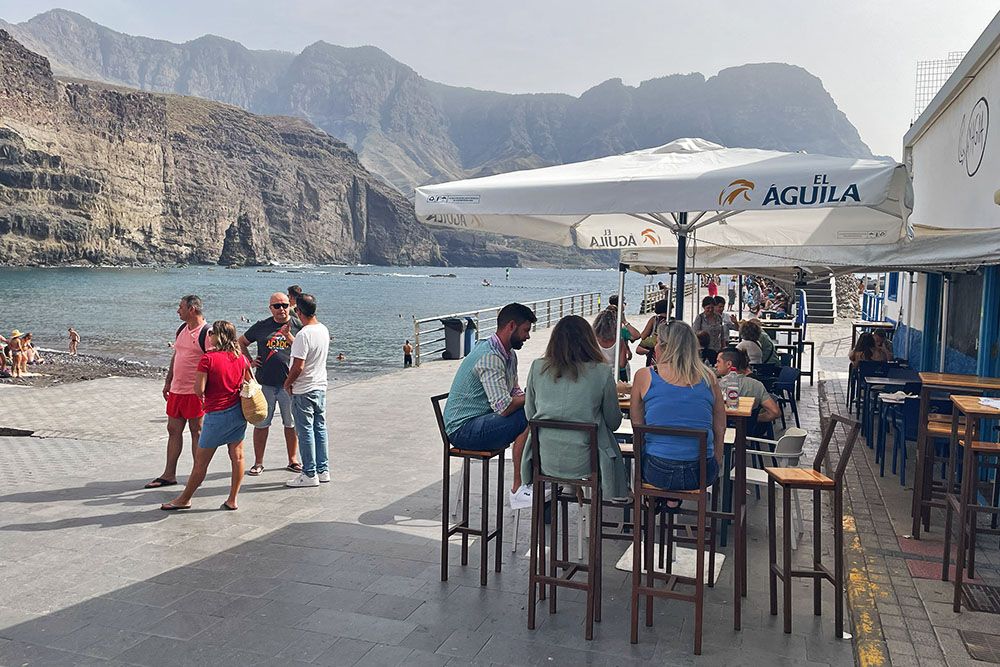
FAQs about holiday destination Gran Canaria
Gran Canaria is part of the Canary Islands, an archipelago in the Atlantic Ocean west of Morocco. The island lies to the east of the islands Tenerife, La Palma, Gomera, and La Frontera, and to the west of the islands Fuerteventura and Lanzarote.
There are many direct flights from Ireland, the United Kingdom, and many other countries in Europe to Gran Canaria.
If you are already on the Canary Islands, for example, for a hiking holiday on La Palma, you can also take the boat to Gran Canaria. The following shipping companies visit Gran Canaria: Biosfera Express, Fred Olsen Express, Líneas Romero, and Naviera Armas. Taking the boat is also an option if you want to bring your own car or camper. First, drive to, for example, Cadiz on the south coast of Spain. Then take the ferry to Las Palmas. Fred Olsen Express covers the long distance in just seven hours.
There are several ways to get around Gran Canaria, depending on the distance you want to travel:
- Hire a car. Renting a car is a popular option on Gran Canaria as it gives you the freedom to explore the island at your own pace. There are several car rental companies at the airport and in tourist areas.
- Public transport. Gran Canaria has a well-developed bus network that connects different parts of the island. Public transport is an affordable option and convenient for travel between cities and tourist destinations.
- Taxis are available in cities and tourist areas. Ask the driver to use the meter or agree on a price for your trip in advance.
- Cycling. For the active traveller, cycling is a fun way to explore the natural beauty of Gran Canaria. You can rent bikes at various locations, and there are special bike paths and routes on the island. Keep in mind that the island is very mountainous, and you will constantly encounter steep slopes. Fortunately, you can also rent e-bikes to conquer the mountains.
- On foot. For short distances in city centres and natural surroundings, walking is a pleasant way to get around. Often, there are sufficient parking facilities for your rental car in cities.
As a holiday destination, Gran Canaria is generally known for:
- Diverse landscape: from beautiful beaches to lush valleys, impressive dunes, and rugged mountains. The island is often referred to as "a continent in miniature" due to the diversity of its natural environment.
- Beaches: Gran Canaria offers beautiful beaches, ranging from lively resorts to secluded coves. Popular beaches include Playa del Inglés, Maspalomas, and Puerto Rico.
- The dunes of Maspalomas, located on the south coast of Gran Canaria. These dunes are a striking natural formation and a popular tourist attraction.
- Historical landmarks: the island has a rich history and is known for its historical sites, including old towns, archaeological sites, and historic buildings.
- Carnival and other festivals. Gran Canaria is known for its colourful and lively carnival celebrations, featuring extravagant parades, music, and dance. But there are also other annual celebrations that are often rooted in religious or ancient traditions, such as the festival in honour of the Virgen del Pino, or El Charco.
- Hiking opportunities: the island offers many hiking trails that traverse diverse landscapes, including mountains, ravines, and forests.
- Gran Canaria's mild and pleasant climate makes the island a popular destination for sun and beach lovers throughout the year.
The best time for a holiday in Gran Canaria is generally from May to September. During these months, there is a pleasant warm climate with plenty of sunshine and very little rainfall. The seawater is warm enough for swimming or engaging in other water sports. If you mainly visit the island for hiking, every month of the year is suitable. Even in winter, Gran Canaria boasts a mild and pleasant climate. Only high in the mountains, it can cool down significantly in winter, with a chance of snow. The last time we were on the island was in March.
Gran Canaria offers numerous unique and interesting attractions, both in nature and in the city. Here are some sights that we believe you shouldn't miss during your visit to this beautiful island:
- Dunas de Maspalomas - The spectacular dunes of Maspalomas form a nature reserve with sand dunes that lead to the sparkling Atlantic Ocean. It's an ideal place for a relaxed walk and to enjoy the beautiful sunset.
- Roque Nublo - This iconic rock, located in the heart of Gran Canaria, offers breathtaking views over the island and the surrounding mountains. It is a popular location for hikers and nature enthusiasts.
- Vegueta - The historic district of Las Palmas, Vegueta, is steeped in charm and history. It houses architectural landmarks such as the impressive Santa Ana Cathedral, Casa de Colón, and numerous picturesque squares and narrow streets.
- Puerto de Mogán - This picturesque fishing village, also known as "Little Venice," is famous for its colourful houses, flowery streets, charming harbour, and lively Friday market.
- Bandama Crater - An impressive volcanic crater with a depth of 200 metres and stunning views over the surrounding landscape. It is a great location for beautiful walks.
There is a great deal to do and experience on Gran Canaria. Here are some popular activities on the island:
Water sports
- Surfing and windsurfing - The beaches of Gran Canaria, such as Playa del Inglés and Las Canteras, are perfect for water sports such as surfing and windsurfing.
- Diving and snorkelling - Explore the beautiful underwater world of Gran Canaria by diving or snorkelling in the clear waters of the Atlantic Ocean.
Outdoor activities in nature
- Hiking and trekking - Explore the breathtaking landscapes of Gran Canaria on foot, with popular hiking routes such as those at Roque Nublo.
- Horse riding - Enjoy a leisurely horseback ride through scenic valleys and mountains.
- Cycling - There are numerous cycling opportunities on the island for both recreational cyclists and road cyclists, with routes of varying difficulty. You will also find many bike rental shops offering various types of bikes.
Culture and history
- Visit to historical landmarks - Discover the rich history of Gran Canaria by visiting sights such as the old town Vegueta and the archaeological site Cueva Pintada. And of course, the island's capital, Las Palmas.
- Local markets and festivals - Explore colourful markets such as the market of Puerto de Mogán and participate in local festivals to experience Canarian culture.
Gran Canaria offers a wide range of accommodations, from luxury resorts to cozy boutique hotels and charming villas. Here are some recommended areas and accommodations to stay on the island:
Maspalomas in the Far South - for Sun and Beaches
- Lopesan Baobab Resort: A luxurious resort with an exotic African atmosphere, extensive pools, and high-quality amenities. Ideal for a luxurious stay.
- Seaside Palm Beach: A stylish and elegant hotel with a retro-chic ambiance, close to the beach and dunes of Maspalomas.
- Other accommodations in the vicinity of Maspalomas.
Las Palmas in the Northeast - for Culture and Beaches
- Santa Catalina, a Royal Hideaway Hotel: A classic and prestigious hotel in colonial style, located in the heart of Las Palmas, ideal for guests who want to explore the city and the beach.
- Boutique Hotel Cordial La Peregrina: Boutique hotel with large, spacious rooms in the city center. It has a very nice rooftop terrace!
- Santa Ana Suite & Rooms: Magnificently located apartment with a beautiful private rooftop terrace.
- Other accommodations in Las Palmas or surroundings.
Puerto de Mogán in the Southwest - for Peace, Sun, and Beaches
- Cordial Mogan Playa: A beautiful resort in Canarian style, surrounded by lush gardens, with multiple pools and a relaxed atmosphere, ideal for an escape from the hustle and bustle.
- Apartamentos Las Palmeras: Lovely apartment in a perfect, peaceful location. Free parking available.
- Other accommodations in the vicinity of Puerto de Mogán.
Vega de San Mateo Inland - for Peace and Outdoor Activities
- Villa el Manantial: A comfortable, spacious, wonderfully secluded place built against the rocks with fantastic views.
- Vivienda Vacacional La Portada: Neat apartment with an incredibly beautiful view. Lovely peaceful surroundings in the mountainous inland.
- El Llanete: Spacious house with a private pool in the beautifully centrally located, cozy village of Vega de San Mateo.
- Other accommodations around Vega de San Mateo.
Are you looking for accommodation truly secluded in nature? Then also take a look at the website of Gran Canaria Natural & Active.
In Gran Canaria, you can indulge in delicious Canarian as well as international dishes. Here are some recommended dining establishments and culinary experiences on the island:
- Restaurante Valle de Mogán - This charming restaurant offers a delightful 10-course lunch with local wine, amidst a picturesque valley. It's not cheap but the stunning surroundings and the delicious food make up for it.
- La Aquarela - A hidden Michelin-starred restaurant offering a blend of international dishes with Canarian influences. Fantastic food! By the way, there are several other Michelin-starred restaurants in Gran Canaria.
- Casa Romántica Agaete - A beautifully located restaurant surrounded by vineyards and gardens, known for the freshness of local dishes and wines. This restaurant is listed in the Michelin Guide.
In addition to these restaurants, there are other interesting dining options, such as Las Rias Bajas for delicious seafood dishes, Casa Del Caminero for simple yet tasty dishes amidst a picturesque mountain village, and I Love Mogan for fresh seafood in a charming harbour. Also, check out the list of good restaurants in Gran Canaria.

